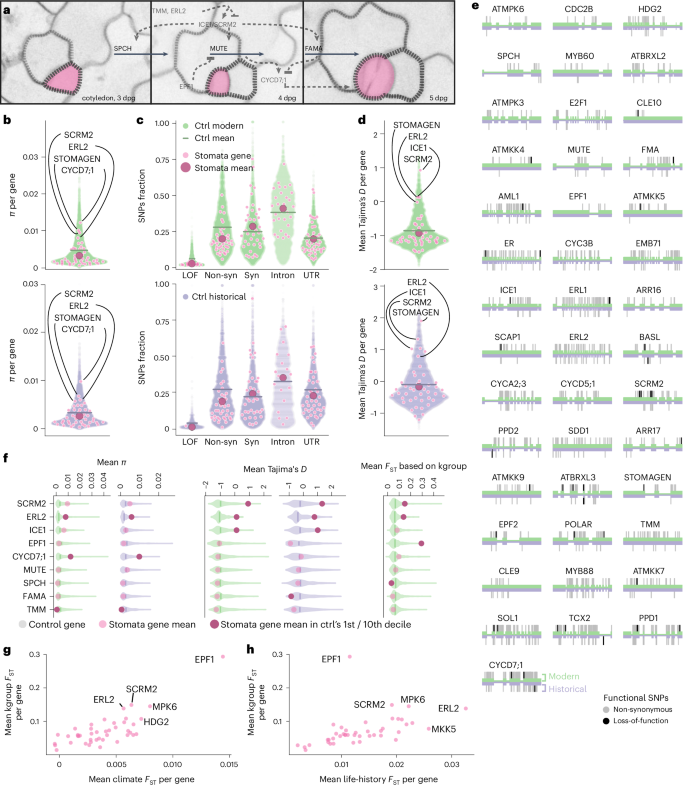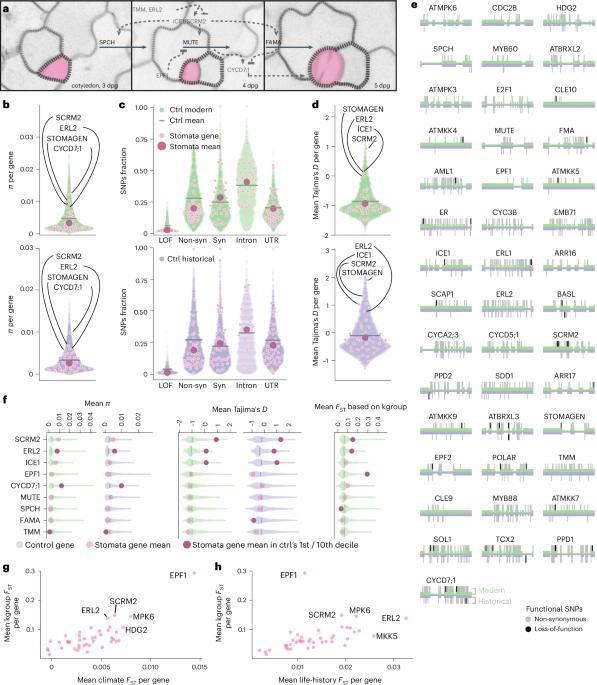Century-long timelines of herbarium genomes predict plant stomatal response to climate change
IF 13.9
1区 生物学
Q1 ECOLOGY
引用次数: 0
Abstract
Dissecting plant responses to the environment is key to understanding whether and how plants adapt to anthropogenic climate change. Stomata, plants’ pores for gas exchange, are expected to decrease in density following increased CO2 concentrations, a trend already observed in multiple plant species. However, it is unclear whether such responses are based on genetic changes and evolutionary adaptation. Here we make use of extensive knowledge of 43 genes in the stomatal development pathway and newly generated genome information of 191 Arabidopsis thaliana historical herbarium specimens collected over 193 years to directly link genetic variation with climate change. While we find that the essential transcription factors SPCH, MUTE and FAMA, central to stomatal development, are under strong evolutionary constraints, several regulators of stomatal development show signs of local adaptation in contemporary samples from different geographic regions. We then develop a functional score based on known effects of gene knock-out on stomatal development that recovers a classic pattern of stomatal density decrease over the past centuries, suggesting a genetic component contributing to this change. This approach combining historical genomics with functional experimental knowledge could allow further investigations of how different, even in historical samples unmeasurable, cellular plant phenotypes may have already responded to climate change through adaptive evolution. Exploring genomic data from contemporary and 191 Arabidopsis thaliana herbarium specimens collected over 193 years, the authors identify signs of local adaptation in regulators of stomatal development in contemporary samples from different geographic regions, then use functional scoring to identify a genetic component contributing to this change.


标本馆基因组长达一个世纪的时间轴可预测植物气孔对气候变化的反应
剖析植物对环境的反应是了解植物是否以及如何适应人为气候变化的关键。气孔是植物进行气体交换的孔隙,随着二氧化碳浓度的增加,气孔的密度预计会降低,这一趋势已在多个植物物种中观察到。然而,目前还不清楚这种反应是否基于基因变化和进化适应。在这里,我们利用对气孔发育途径中 43 个基因的广泛了解,以及新生成的 191 个拟南芥标本馆历史标本的基因组信息,将基因变异与气候变化直接联系起来。我们发现,对气孔发育至关重要的转录因子 SPCH、MUTE 和 FAMA 受到了强烈的进化限制,而在来自不同地理区域的当代样本中,气孔发育的几个调控因子则显示出局部适应的迹象。然后,我们根据已知基因敲除对气孔发育的影响,制定了一个功能评分,恢复了过去几个世纪气孔密度下降的经典模式,表明这一变化与遗传因素有关。这种将历史基因组学与功能实验知识相结合的方法可以进一步研究不同的(甚至在历史样本中无法测量的)细胞植物表型如何通过适应性进化来应对气候变化。
本文章由计算机程序翻译,如有差异,请以英文原文为准。
求助全文
约1分钟内获得全文
求助全文
来源期刊

Nature ecology & evolution
Agricultural and Biological Sciences-Ecology, Evolution, Behavior and Systematics
CiteScore
22.20
自引率
2.40%
发文量
282
期刊介绍:
Nature Ecology & Evolution is interested in the full spectrum of ecological and evolutionary biology, encompassing approaches at the molecular, organismal, population, community and ecosystem levels, as well as relevant parts of the social sciences. Nature Ecology & Evolution provides a place where all researchers and policymakers interested in all aspects of life's diversity can come together to learn about the most accomplished and significant advances in the field and to discuss topical issues. An online-only monthly journal, our broad scope ensures that the research published reaches the widest possible audience of scientists.
 求助内容:
求助内容: 应助结果提醒方式:
应助结果提醒方式:


